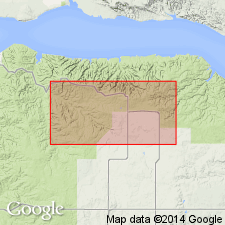
- Usage in publication:
-
- Grondale Formation
- Modifications:
-
- Named
- Dominant lithology:
-
- Sandstone
- Siltstone
- Limestone
- Dolomite
- AAPG geologic province:
-
- Williston basin
Summary:
Named as a subsurface formation (one of eight) in the Interlake Group for the Kissinger 1-9 Grondale well in sec 9, T155N, R94W, Mountrail Co, ND in the Williston basin. The type section is between 12,840 and 12,952 ft--or 112 ft thick--in the Grondale well. Overlies Cedar Lake Formation (extended into the U.S. from CN) of the Interlake Group. Underlies Mendenhall Formation (named) of Interlake Group. Both contacts easily identified by their radioactive responses. Described as a quartz-bearing unit or as a distinctive quartz sand-bearing unit, or as a variegated red/ green sequence of argillaceous silty carbonate [limestone/ dolomite] interbedded with quartz sandstone and siltstone. Deposited in a humid climate. Derived from Cambrian and Ordovician sandstone. Silurian age. Stratigraphic nomenclature history chart. Assigned to the lower part of the "upper Interlake beds" by some earlier workers.
Source: GNU records (USGS DDS-6; Denver GNULEX).
For more information, please contact Nancy Stamm, Geologic Names Committee Secretary.
Asterisk (*) indicates published by U.S. Geological Survey authors.
"No current usage" (†) implies that a name has been abandoned or has fallen into disuse. Former usage and, if known, replacement name given in parentheses ( ).
Slash (/) indicates name conflicts with nomenclatural guidelines (CSN, 1933; ACSN, 1961, 1970; NACSN, 1983, 2005, 2021). May be explained within brackets ([ ]).

